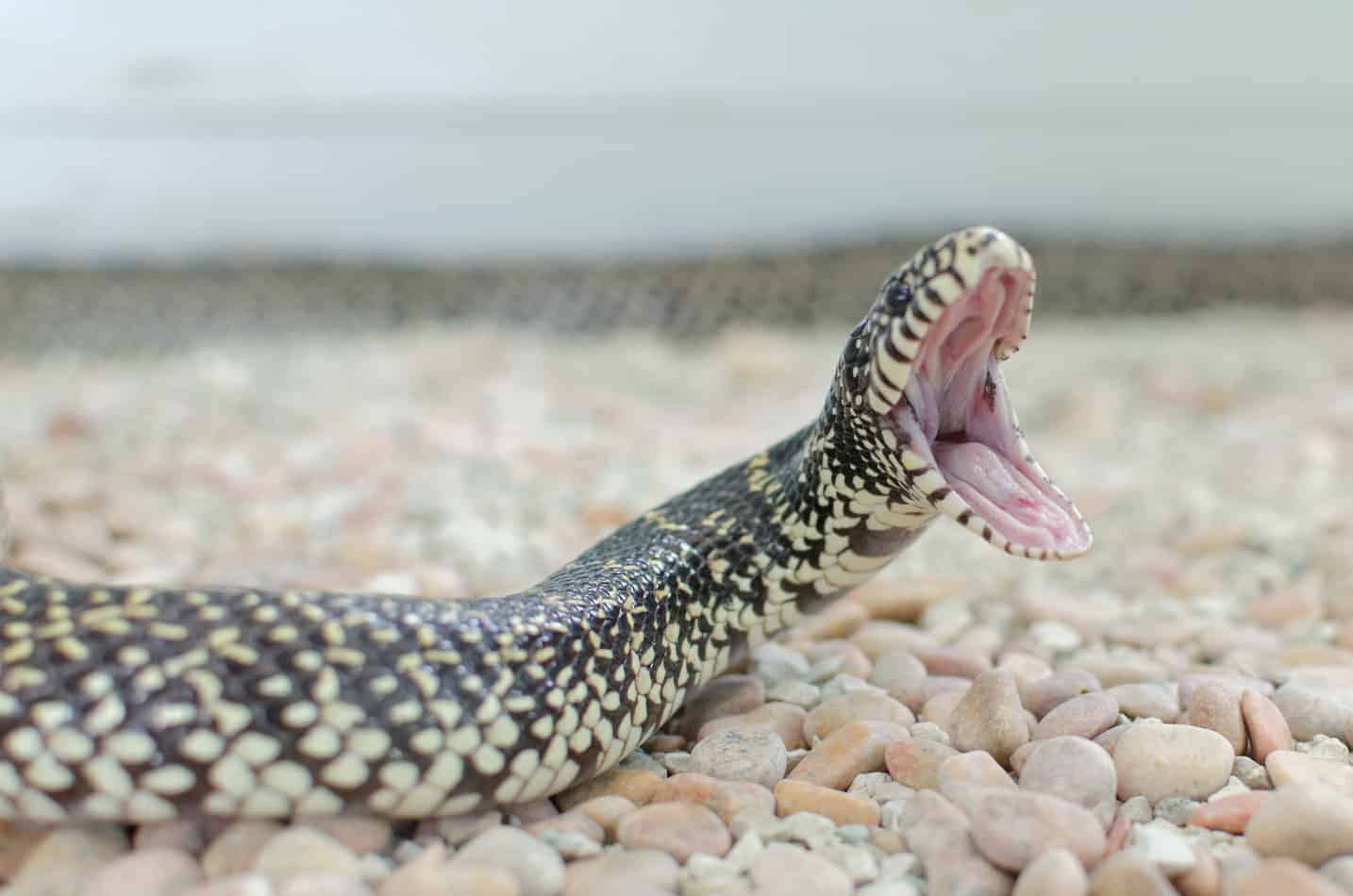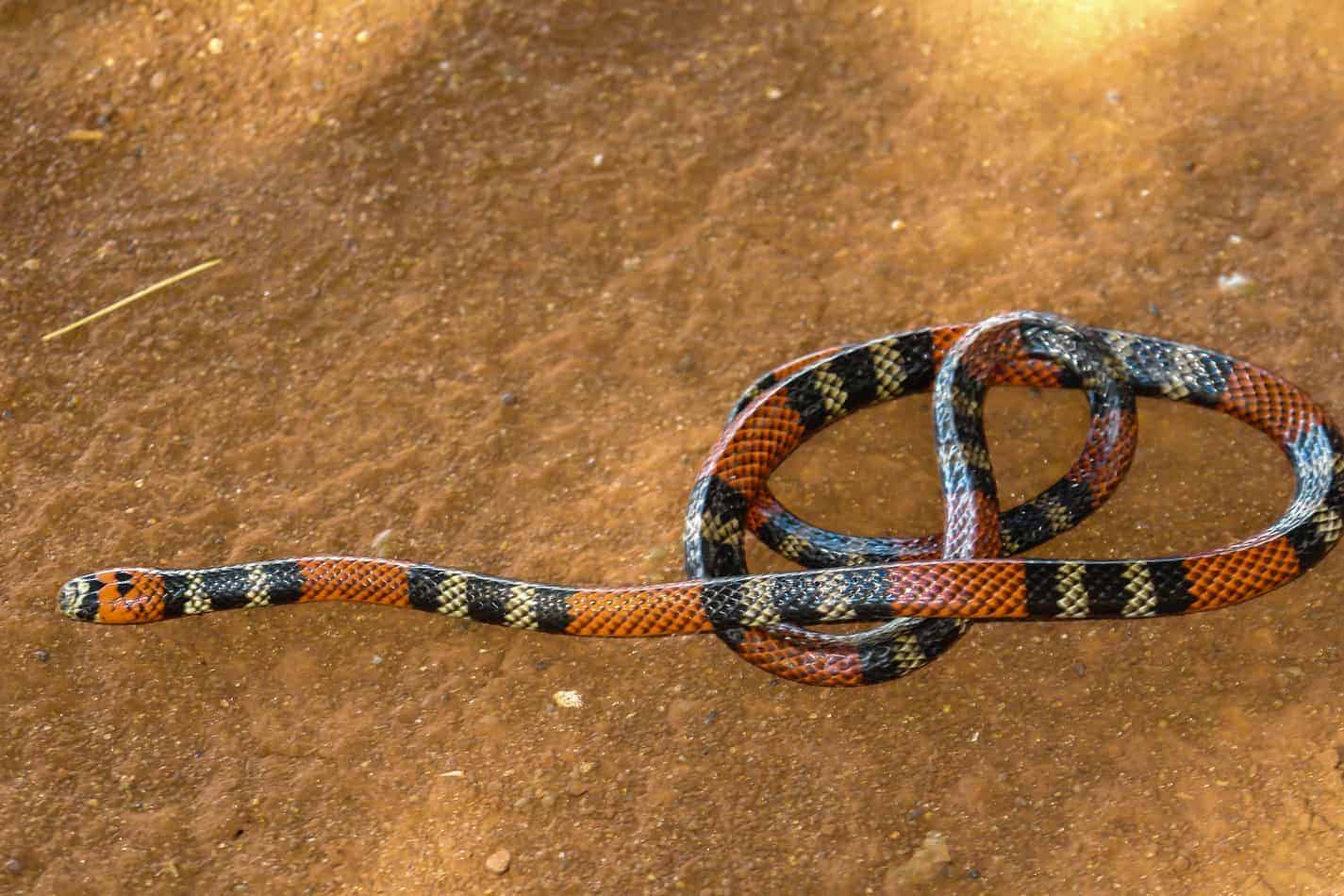Are King Snakes Poisonous?

Hearing a name like “king snake” makes you wonder if they’re poisonous. The king snake has a very regal name, and you might wonder if there is some force to back it up. I did some research to find out.
Are king snakes poisonous? King snakes are not poisonous. They don’t have any venom. They are harmless to humans and don’t even bite if provoked. They do, however, have a tolerance for snake venom from other snakes. When threatened, king snakes will emit a bad-smelling musk, but that is the extent of their level of danger. They are popular pets and are relatively docile creatures.
There is more to the king snake than meets the eye. Even though
How do King Snakes Kill Their Prey Without Venom?
King snakes have many different ways they can kill and consume their prey without the use of venom. For starters, king snakes are considered constrictors. Constrictors are a type of snake that can overwhelm their victims by merely squeezing them until they’ve suffocated.
It takes a lot of pressure and power to be able to strangulate each victim, and the king snake does this beautifully. Apparently, the squeezing cuts off all blood flow to the brain, causing something called ischemia.
Definition of Ischemia: an inadequate blood supply to an organ or part of the body, especially the heart muscles.
King snakes are avid hunters and they swallow their prey whole. The size and powerful grip of the king snake are enough for them to be able to get by without the use or need for venom.
King snakes can exert twice as much the constriction force as their own body size. Pretty impressive. Imagine if a human could that, that’d be pretty crazy! This snake’s size alone is what causes other snakes to cower and scatter. They can ‘clear the room’ without ever having to get on the offensive.
The King Snake Name
King snakes are rightly named because they are the king of snakes. How are they the king of snakes you might ask, well, I’ll tell you.
They are just so because they are immune to the snake venom of other snakes, and their prey includes that of other king snakes. There aren’t any other snakes besides their own kind which can eat them.
They are at quite a high level on the snake food chain and have many natural instincts at their fingertips, which help them to succeed in hunting, escaping their predators, and surviving in the wild.
They can be very small to very large. They may be docile, but they are considered pretty powerful creatures in the snake world. It is certain that their name has many different references towards their nature.
What Makes King Snakes Immune to Venom?
King snakes are able produce an enzyme in their body that breaks down the venom for them. This reduces the risk of damage in their body and allows them to consume and digest common venomous snakes such as the copperhead, rattlesnake, cottonmouth water, water moccasins, and even coral snakes.
The king snake is not immune to all venom. They are resistant to most venomous snakes. Their body has a protection system which has evolved over time to help them out with the digestion of the more venomous kinds of snakes.
Fun Fact: Scientists have learned how to take antivenom from snakes and use it in humans to save them from venomous snake bites!
Even though they are not immune to all venom, their capacity to consume all of these very venomous snakes makes it a formidable opponent and a very fun pet.
Do King Snakes Have Fangs?
King snakes do not have fangs. Being a constrictor, they don’t really need them. It’s the venomous snakes that use fangs, not the constrictors. They have teeth but they aren’t very dangerous.
They have a small row of teeth on the top and bottom. They use these teeth for the ease of swallowing their prey. They do the job well enough for the King snake that they don’t have to worry about the fact that they don’t have fangs.
How Does a King Snake Defend Itself?
Interestingly enough, some king snakes are often mistaken for their extremely venomous counterpart, coral snakes. This provides an unusual tool for them to use in protecting themselves against their attackers.
There are other kinds of king snakes, but this particular one is good at looking like the dangerous enemy. Some king snakes possess a similar red, black, and white pattern as Coral snakes.
King snakes flash their colors in the underbrush, or in the light of the sun, to try and trick its predators that it is a deadly coral snake, instead of a docile kingsnake. That’s only one method it uses. Sometimes it will play dead, or even spread its fecal matter on its attacker. (Ew!)
Aside from that, it emits a musk that discourages its predators to attack. It’ll even swish its tail back and forth to mimic a rattlesnake rattling sound. The king snake is a very intelligent and resourceful reptile and has many ways to defend itself.
How Can I Tell the Difference Between a Coral Snake and a King Snake?

The pattern of a King snake will just as easily confuse a human as it will an animal that is on the prowl. However, you should not get too worried. While the pattern of a coral snake and a common king snake bear a striking resemblance, there is a difference.
Warning: Never go looking for a Coral snake in the wild. They are dangerous. Let the professionals do that. It may sound like fun at first, but when you’re in the hospital because you wanted to go play with the Coral snakes don’t come crying to me. I told ya!
For starters, the coral snake has a black nose which is a pretty good indicator that it’s not a king snake. However, to determine which is more dangerous, all you have to do is observe the colors. If it’s red on black, it’s a king snake. If it’s red on yellow, it’s a coral snake.
That’s one way to tell, and I also found another way to tell on a website called Wildlife Removal. If you aren’t good at remembering important things like what color a snake is, there’s a rhyme on this website that can help you remember it better.
Red Touch Yellow – Kills a Fellow
Red Touch Black – Venom Lack
Yellow Touches Red – Soon You’ll Be Dead
Red Touches Black – Friend of Jack
This rhyme is probably one of the oldest ones in the book. If you can remember that, then you’ll probably be safe for the time being. If you still aren’t sure, ask an expert for help.
Fun Fact: Both Coral snakes and King snakes are docile. Neither will bother you if you don’t bother them. You would have to be intentionally trying to agitate them to get them to bite you…which you probably wouldn’t be doing.
You might be surprised at how useful this information could become in the future. If you ever find yourself in areas where the Coral and King snake are more prevalent, you’ll have at least a small bit of information to give you a better chance of knowing how safe you really are.
Related Questions
Where might I buy a king snake? The most popular place to purchase a king snake is online. There are many websites that sell exotic snakes for relatively cheap prices. One popular snake buying platform is Snakes at Sunset. Make sure to review shipping prices before purchases because you might be paying more than you anticipated.
What are some other types of constrictors? Well, for starters, there’s the Boa Constrictor. You may have seen this creature on TV. It is the more famous of the Constrictors. Some other constrictors include the ball python and Anaconda.
What should I do if I am bitten by a Coral snake? Get to a medical facility as fast as possible! Keep the bite below the level of your heart and drive as fast as possible. However, Coral snakes are pretty shy so it’s unlikely that you will be bitten by one.
